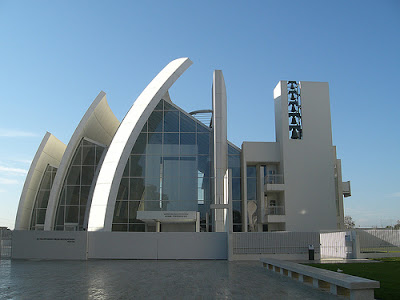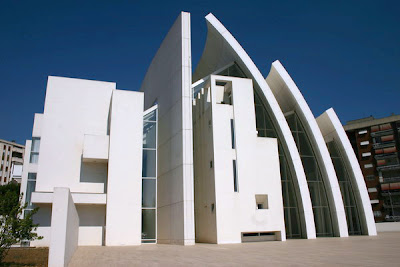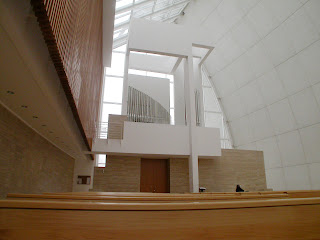VERSIÓN EN ESPAÑOL.
"First God made heaven and earth. The earth was without form and void, and darkness was upon the face of the deep; and the Spirit of God was moving over the face of the waters. And God said, "Let there be light"; and there was light. And God saw that the light was good; and God separated the light from the darkness"
Gen. 1, 1-4. Gen. 1, 1-4.
And with this first material, the most eternal and universal of all materials, so important to Christianity and to other religions, is that Tadao Ando gives shape to his Church of Light (1989).

Located in a hidden corner, in a quiet residential suburb in Ibaraki, Osaka, this small complex comprises two modest buildings, arranged at an angle, oriented according to the urban pattern of the neighborhood.

See location on Google Maps.
 3D image by Carlos Zeballos
3D image by Carlos Zeballos
The access to the compound was made intentionally indirect, unlike many churches in the West. Visitors are forced to enter the complex at the northeast corner through a side street via a forecourt that leads to a corner of the church near the minister's house, arriving to an area located in the back of the church. From there one enters to a tiny little square, which houses a circular bench. Through This space organizes the accesses to the main church and adjacent chapel.

As noted by Philip Drew, in Zen art "beauty is to highlight the epiphany of the shapeless, absolute void that is God." Thus, the void is equivalent to infinity and vice versa. Therefore, Ando's architecture represents this void as a kind of divine fullness, and the imperfect finishes reflect the spirit of the Japanese wabi sabi .

Based on very simple elements like rectangular boxes and intersecting planes, Ando modelled the churches using light and space. The main church, is a 6 x 6 x 18 m box, laterally crossed by a wall rotated 15 degrees from the main axis of the nave.
Ando's merit lies not only in introducing this element obliquely, that brings dynamism to the serene orthogonal space of the nave, but to separate it a few inches from the roof, allowing light to filter horizontally and giving the impression that the roof is floating in the air.

This diagonal wall also contains a 1.60 x 5.35 m glass sliding screen and the gateway to the room, as in a traditional Japanese shoji.

Behind the altar there is a cross-shaped opening, bathing the interior space with the power and energy of light.

Light is the only natural element that enters the environment as reinforcing its divine character and invading the profane darkness.

The building, constructed in concrete, has given up any ornament in favor of the spirituality that gives light, enhancing its sacredness. Due to the reduced budget at the short time of construction, the main church had no special elements aside of the concrete walls and the calculated openings, and probably because of that, is that the church transmits such strong spirituality.
Planks and other parts of the scaffolding used during building construction were re-utilized as the floor and benches inside the church, finished with a black oil stain, harmonizing with the austere and minimal character of the place. The furniture and the severity of the grim ambient that houses it, combined with the lively and ever-changing performance of light and shadow, manage to provide stress and intensity along with purity and tranquility, which is in itself the essence of the spirituality that this space conveys.

In the small chapel adjacent to the main church (1997), Ando repeats the theme of the box crossed by an oblique plane, slightly detached from the roof.
Pero esta vez no incluye una abertura en cruz, sino que practica una hendidura en el techo a traves de la cual baña con luz rasante la desnuda pared del altar. But this time the chapel does not include an opening in the shape a cross, but practices a slit in the roof through which light bathes the bare wall of the altar.

Despite its simplicity, the oblique plane, the wall and the skylight are assembled in a spectacular choreography of forms, surfaces and tones.

Nature is always a reference in traditional Japanese architecture. Thus the fluidity of the relationship between interior and exterior. Upon entering the chapel and looking to the right, a long window reveals a simple allegory to the cross, resting on greenery and water.

The presence of nature, reduced to the element of light, takes a highly abstract character, and responding to this abstraction, pure architecture grows with the daily passage of time. The few but precise openings placed in this space, enhance the bright of light against a background of darkness.
The humbleness of the materials (rough concrete, metal and glass) and furniture, the poetry of the geometry enhanced by the dramatic use of light offers a special experience of beauty and spirituality. Tadao Ando once again demonstrates his mastery in this simple building, achieving a perfect unity of matter and spirit, reflecting the very essence of Christianity, but expressing it through the simplicity of Zen Buddhism.
“Mystery and its manifestations arise from the same source. This source is called darkness. Darkness within darkness. Light is the gateway to all understanding."

Located in a hidden corner, in a quiet residential suburb in Ibaraki, Osaka, this small complex comprises two modest buildings, arranged at an angle, oriented according to the urban pattern of the neighborhood.

See location on Google Maps.
 3D image by Carlos Zeballos
3D image by Carlos ZeballosThe access to the compound was made intentionally indirect, unlike many churches in the West. Visitors are forced to enter the complex at the northeast corner through a side street via a forecourt that leads to a corner of the church near the minister's house, arriving to an area located in the back of the church. From there one enters to a tiny little square, which houses a circular bench. Through This space organizes the accesses to the main church and adjacent chapel.

As noted by Philip Drew, in Zen art "beauty is to highlight the epiphany of the shapeless, absolute void that is God." Thus, the void is equivalent to infinity and vice versa. Therefore, Ando's architecture represents this void as a kind of divine fullness, and the imperfect finishes reflect the spirit of the Japanese wabi sabi .

Based on very simple elements like rectangular boxes and intersecting planes, Ando modelled the churches using light and space. The main church, is a 6 x 6 x 18 m box, laterally crossed by a wall rotated 15 degrees from the main axis of the nave.
Ando's merit lies not only in introducing this element obliquely, that brings dynamism to the serene orthogonal space of the nave, but to separate it a few inches from the roof, allowing light to filter horizontally and giving the impression that the roof is floating in the air.

This diagonal wall also contains a 1.60 x 5.35 m glass sliding screen and the gateway to the room, as in a traditional Japanese shoji.

Behind the altar there is a cross-shaped opening, bathing the interior space with the power and energy of light.

Light is the only natural element that enters the environment as reinforcing its divine character and invading the profane darkness.

The building, constructed in concrete, has given up any ornament in favor of the spirituality that gives light, enhancing its sacredness. Due to the reduced budget at the short time of construction, the main church had no special elements aside of the concrete walls and the calculated openings, and probably because of that, is that the church transmits such strong spirituality.
Planks and other parts of the scaffolding used during building construction were re-utilized as the floor and benches inside the church, finished with a black oil stain, harmonizing with the austere and minimal character of the place. The furniture and the severity of the grim ambient that houses it, combined with the lively and ever-changing performance of light and shadow, manage to provide stress and intensity along with purity and tranquility, which is in itself the essence of the spirituality that this space conveys.
In the small chapel adjacent to the main church (1997), Ando repeats the theme of the box crossed by an oblique plane, slightly detached from the roof.
Pero esta vez no incluye una abertura en cruz, sino que practica una hendidura en el techo a traves de la cual baña con luz rasante la desnuda pared del altar. But this time the chapel does not include an opening in the shape a cross, but practices a slit in the roof through which light bathes the bare wall of the altar.

Despite its simplicity, the oblique plane, the wall and the skylight are assembled in a spectacular choreography of forms, surfaces and tones.

Nature is always a reference in traditional Japanese architecture. Thus the fluidity of the relationship between interior and exterior. Upon entering the chapel and looking to the right, a long window reveals a simple allegory to the cross, resting on greenery and water.

The presence of nature, reduced to the element of light, takes a highly abstract character, and responding to this abstraction, pure architecture grows with the daily passage of time. The few but precise openings placed in this space, enhance the bright of light against a background of darkness.
The humbleness of the materials (rough concrete, metal and glass) and furniture, the poetry of the geometry enhanced by the dramatic use of light offers a special experience of beauty and spirituality. Tadao Ando once again demonstrates his mastery in this simple building, achieving a perfect unity of matter and spirit, reflecting the very essence of Christianity, but expressing it through the simplicity of Zen Buddhism.
“Mystery and its manifestations arise from the same source. This source is called darkness. Darkness within darkness. Light is the gateway to all understanding."





























